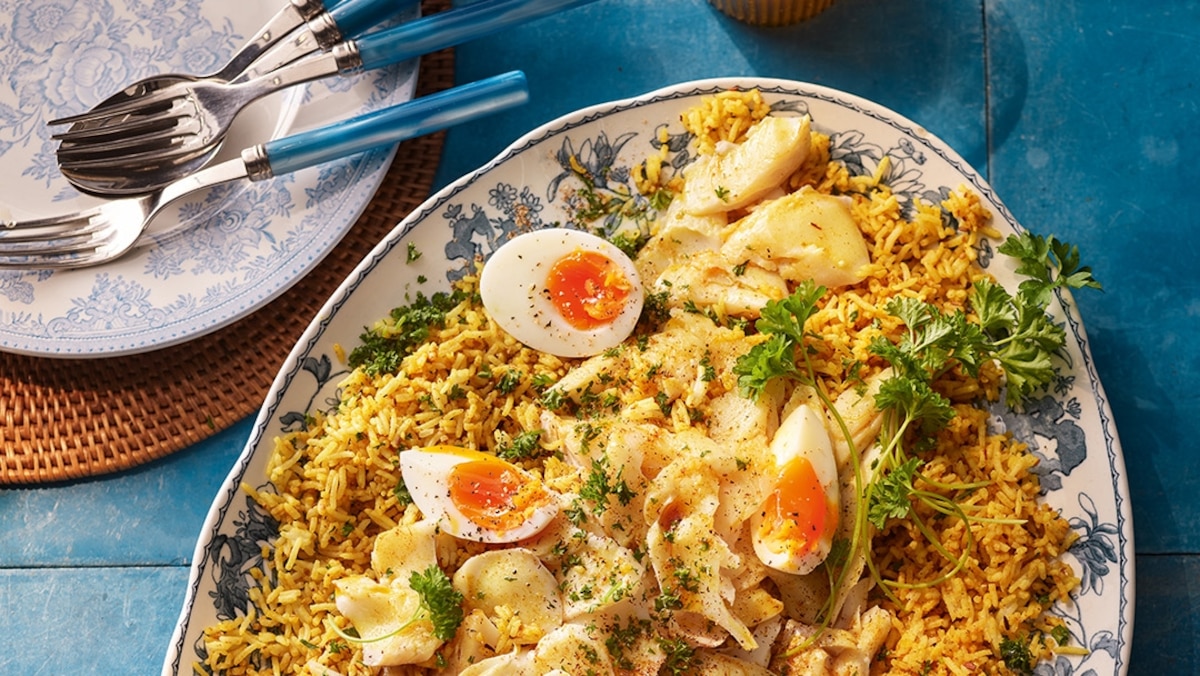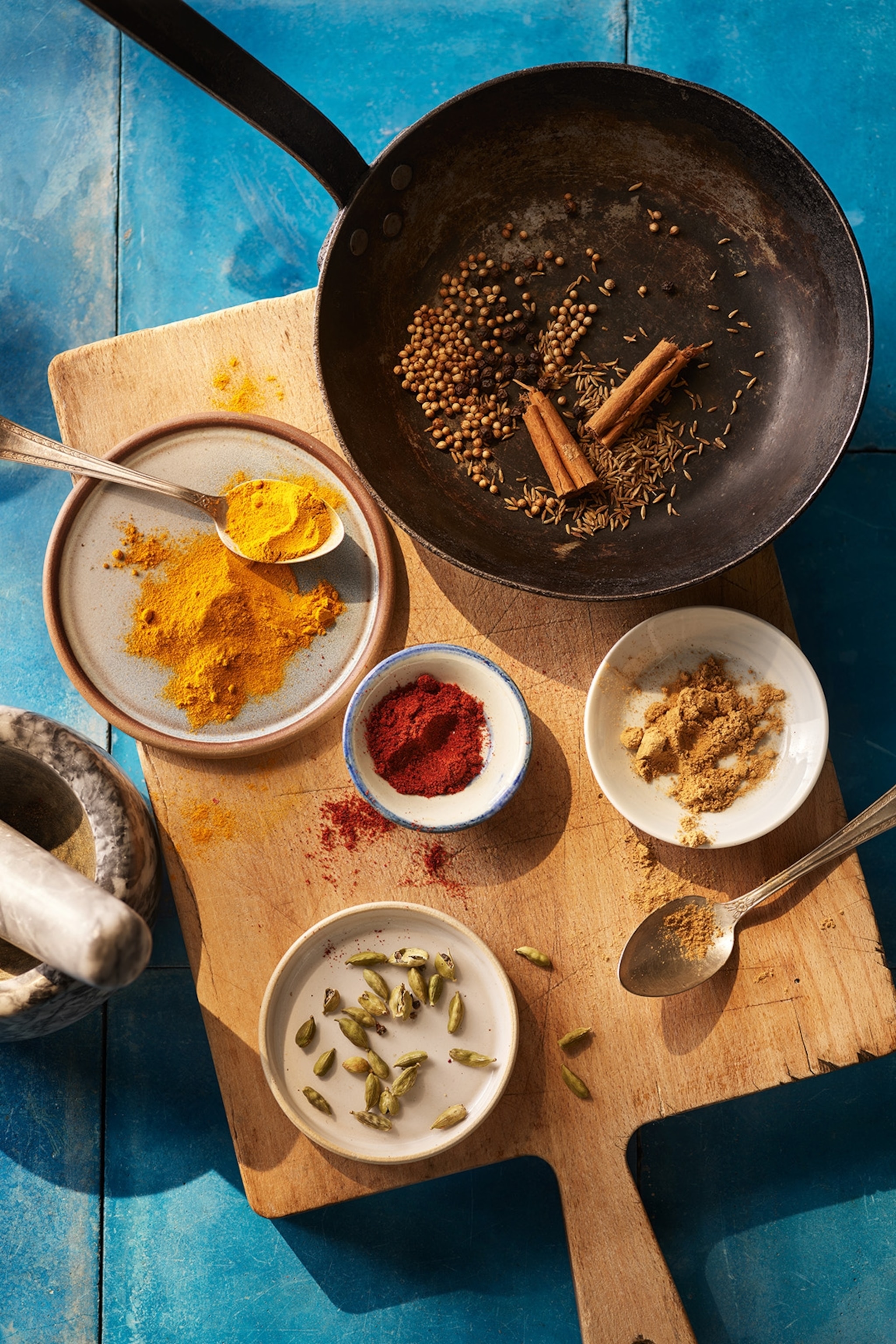Now Reading: What is kedgeree: the British breakfast classic that originated in India
-
01
What is kedgeree: the British breakfast classic that originated in India
What is kedgeree: the British breakfast classic that originated in India

This article was produced by National Geographic Traveller (UK).
Smoked fish flaked into gently spiced rice, topped with egg — kedgeree is a beloved breakfast dish that’s also enjoyed for brunch, lunch and dinner around the UK. Yet its origins can be traced back to India, centuries ago.
It’s derived from khichdi, a one-pot rice and lentil dish synonymous with both comfort and celebration in South Asia. The earliest written references to khichdi — whose name comes from the Sanskrit word khiccā, meaning a mixture of rice and lentils — appear in the Indian epic Mahabharata, believed to have been compiled between the third century BCE and fourth century CE.
Khichdi has since spread globally, but it first captured English hearts when it made its way onto the tables of East India Company staff in their early days as traders in India in the 17th and 18th centuries. Back then, the company’s employees were mostly eating local food. Englishman John Grose, who travelled to India in the 1750s, wrote that many even preferred this ‘country-diet’ as it tasted better than their own cuisine and was more suited to the climate.
In the absence of precise historical records, one can at best infer how khichdi transformed into kedgeree. “Khichdi would have been served as a soothing dish at breakfast,” says food historian and author Lizzie Collingham. “The British enjoyed eggs for breakfast and fish would have been served in the mornings, while it was still fresh, before the arrival of the fridge.” The lentils were eventually abandoned, and khichdi became kidgeri, then kedgeree. It travelled back to Britain via returning officials, soldiers and traders along with a taste for ‘curry’, the generic word they used to describe Indian cuisine.
Commercial curry powder was advertised as early as the mid-1780s, according to Laura Kelley, author of The Silk Road Gourmet. The first known written instructions for making kedgeree were recorded soon after, by Scottish woman Stephana Malcolm, in a diary she started in 1790. While Malcolm spent most of her life in rural Dumfriesshire, her three brothers travelled extensively. One of them, John, rose to prominence in the East India Company as the Governor of Bombay, opening her eyes and palate to dishes such as kedgeree and mulligatawny soup.
Malcolm’s recipe, available on the National Library of Scotland’s website, uses ‘cold boiled haddock’ or ‘a bit of cod’ along with ‘minced’ hard-boiled eggs warmed in butter. Cayenne pepper is the only spice. Her fish and rice are freshly prepared, but the NLS notes that by Victorian times, thrifty housewives often made kedgeree from leftover ingredients. Curried dishes were seen as a frugal way to transform produce and give leftovers a fresh lease of life, says Collingham.

Kedgeree can be elevated by using homemade curry powder. Any extra can be stored in an airtight container for later use.
Photograph by Jamie Orlando Smith

Gently warm milk in a large pan. Then, halve the fish fillets and place them in the milk, skin side up. Cover and poach on a high simmer for eight minutes until cooked and flaky.
Photograph by Jamie Orlando Smith
As the ambitions of the British in India went from commerce to colonisation in the 18th and 19th centuries, their eating habits evolved. While soldiers in camps and rural areas would continue to consume traditional Indian food, the higher-ranking officers in towns and cantonments would create more anglicised big feasts, or ‘burra khanas’, writes food historian David Smith in his 2019 paper, ‘The Sublime Art of Curry-Making: Culinary Trends in British India’. And with more British officials being stationed in India during the height of the Empire as military ambitions intensified, Indian food fell off the main menu, with Anglo-Indian dishes gaining favour at formal dinners and banquets.
Over in Britain, the same dishes found their way to upper- and middle-class Victorian tables. Up until the early 19th century, breakfast was a mostly frugal meal, but this changed during Queen Victoria’s reign. In her book A History of English Food, Clarissa Dickson Wright describes how, from the 1830s, breakfast became a ‘rather elaborate meal’ served from about 10am. While Queen Victoria would enjoy a boiled egg with a golden spoon, others around her would tuck into a feast that included ‘fancy dishes such as kedgeree or devilled kidneys’. In 1861, the queen’s chief cook, Charles Elmé Francatelli, even created and published a version of kedgeree for ‘curry’-loving Florence Nightingale.
By 1845, the advent of the railways had made the transport of smoked fish more convenient. Collingham suggests that the upper classes would have been familiar with Scottish smoked fish from their hunting parties there. Kippers (smoked herring) started becoming popular for breakfast in southern England, and the stagecoach connection from Findon, south of Aberdeen, to Edinburgh and London shot finnan haddie (smoked haddock) to fame. The method of curing didn’t give the fish a long shelf life, so it made sense to flake it into kedgeree to save on waste and infuse the dish with flavour.
In 1845, Eliza Acton published Modern Cookery for Private Families, featuring a version of the dish with ‘slightly beaten eggs’ stirred through. She suggests that ‘cold turbot, brill, salmon, soles, John Dory and shrimps, may all be served in this form’ and recommends ‘Mauritian chatney’ as an accompaniment.
Mrs Beeton’s 1861 kedgeree recipe, meanwhile, incorporates smoked haddock but omits curry powder, which does appear in her other Anglo-Indian dishes. Following her death, the brand franchise was sold to publishers Ward, Lock & Co, which printed recipes for versions with boiled fish, lentils and even chopped cold meat well into the middle of the 20th century.
Curry powder eventually made its way into this quick, family-pleasing, fusion dish that became as acceptable for supper as for breakfast. And today, despite plenty of variation, there are some common denominators — long-grain or basmati rice, eggs and fish. However, recipes tend to fall into two camps: a low-waste version suitable for home cooks and a richer, more lavish rendition that would please a royal court. The former tends to be lighter, with an optional splash of cream, and the egg is mostly hard-boiled. The latter, meanwhile, is often heavier. Double cream and lemon might feature. The egg could be soft-boiled or poached and perched atop the rice, for added theatre and creaminess. It’s found on the menu at high-end restaurants and has enjoyed a resurgence since featuring in the first episode of Downton Abbey in 2010.
Kedgeree is one of the most popular breakfast dishes at The Ritz London, and the hotel’s 2018 cookbook recipe requires the creation of a curry sauce to serve alongside it, complete with cardamom, ginger and cumin alongside curry powder and chicken stock.

Melt your butter and mix in a generous tbsp of curry powder before pouring into the rice.
Photograph by Jamie Orlando Smith

Fold the golden curry butter mixture into fork-fluffed rice before adding fish and nutmeg until everything is incorporated.
Photograph by Jamie Orlando Smith
At Francatelli restaurant, in London’s St James’s Hotel & Club, chef William Drabble serves modern versions of recipes inspired by Queen Victoria’s cook. He alternates between a lighter, more homely version and something closer to risotto. “It’s good, tasty, healthy, honest and comforting; I don’t think it gets enough recognition,” he says of kedgeree.
Many chefs, food writers and restaurateurs are making an effort to change this, however, putting it back on the menu and adding their own flourishes. Pete Taylor, co-owner of posh London fish-and-chip restaurant The Mayfair Chippy, has created a kedgeree scotch egg with milk-poached smoked haddock and spiced rice.
At Vandal restaurant in Warrington, kedgeree is made with miso-baked cod, spinach, katsu curry and a poached egg, before being smoked and unveiled at the table from under a cloche. And chef Shuko Oda of London’s Koya serves a Japanese-British version for breakfast, flavoured with bonito and niboshi (dried anchovy).
In Edinburgh, Kelsey Garthwaite, owner of Pie Dolly, has captured the flavour of kedgeree in a quiche, complete with a turmeric pastry crust. She describes kedgeree as a typical Edinburgh dish, although it’s not easy to find a classic version in the Scottish capital nowadays. Roseleaf bar and cafe in Leith, however, has served it since 2007, made to an old family recipe. “We’re using our grandmother’s recipe here and at home. Kedgeree is perfect just the way it is. Why mess with it?” says owner Graham Parsons. Perhaps this explains kedgeree’s enduring appeal. It’s perfect just the way it is and the best way to cook it is however you wish.

The best way to cook kedgeree is exactly how you wish.
Photograph by Jamie Orlando Smith
Mallika Basu’s kedgeree
Inspired by home-cooked versions, this kedgeree is elevated by home-made curry powder. You could add a splash of double cream and a squeeze of lemon juice if you like, and extra powder can be stored in an airtight container for later use.
Takes: 30-35 mins
Serves: 4-6
Ingredients
300g basmati rice, uncooked
500ml whole milk
4 undyed smoked boneless haddock fillets, halved
4-6 medium eggs
50g butter
quarter nutmeg, freshly grated
curly parsley to serve (or flat leaf parsley, coriander or dill)
For the curry powder
1½ tsp coriander seeds
1½ tsp cumin seeds
6 black peppercorns
half-inch stick cinnamon
1 tsp ground ginger
2 tsp turmeric
½ tsp hot chilli powder
2 green cardamom pods, seeded
METHOD
To make the curry powder, toast the coriander, cumin and black peppercorns in a small pan over a medium heat for 30 seconds, shaking gently until warm. Tip into a spice/coffee grinder with the cinnamon stick, ginger, turmeric, chilli powder and green cardamom seeds and grind to a fine powder (if you don’t have a spice grinder, use a pestle and mortar to powder the toasted spices, then mix in the other ingredients). Set aside.
Rinse the rice, drain and leave in the sieve. Gently warm the milk in a pan large enough to hold the haddock fillets. Halve the fillets and place, skin side up, in the pan. Cover and poach on a high simmer for 8 mins until cooked and flaky — the skin should peel easily off the thickest fillet if you run a butter knife under it.
Transfer the fish to a plate using a slotted spoon and strain the milk into a measuring jug. Add just-boiled water to make it up to 600ml. Pour into the saucepan the rice was rinsed in, then bring to a rapid boil, tip in the rice, bubble quickly and cover and simmer for 12 minutes until cooked. Remove from the heat and move to a cool spot, leaving the lid on.
Put the eggs in a pan of cold water and boil for 6-8 mins. Drain, submerge in cold water, peel and slice. Remove the skin from the cooked haddock and flake the fish.
Melt the butter in a large, non-stick saucepan. Mix in a generous tbsp of the curry powder, then fold in the fork-fluffed rice, fish and nutmeg until everything is well incorporated. Add salt to taste. Serve with the sliced eggs and scatter with the chopped parsley.
Published in Issue 27 (spring 2025) of Food by National Geographic Traveller (UK)
To subscribe to National Geographic Traveller (UK) magazine click here. (Available in select countries only).























